This September and October, we’re taking a look at the jam-packed 1994 to 1995 season of Star Trek, including Star Trek: Deep Space Nine and Star Trek: Voyager. Check back daily for the latest review.
Broadcast as the second episode of the second season, Initiations was the first episode produced as part of the second season of Star Trek: Voyager. As three of the four shows carried over from the first season – Projections, Elogium and Twisted – were essentially budget-saving bottle shows, the plan was to shuffle some location-heavy episodes into the broadcast order to offer something a bit more exciting and engaging.
Initiations also marked the return of producer Michael Piller to the fold. Piller had left Voyager mid-way through the first season to work on another science-fiction show for UPN. After Legend was cancelled, Piller returned to work on Voyager and found himself presiding over a very troubled second season. The second season of Voyager would be the last time that Piller was actively involved in a season of Star Trek, and so it feels like a pretty momentous occasion for the franchise.
While not spectacular, and suffering from some lingering Kazon-related problems, Initiations is still an effective forty-five minutes of television.
The Kazon were originally envisioned as a metaphor for Los Angeles street gangs. As Michael Piller explained to Cinefantastique:
The Kazon were intended to be [like] Los Angeles street gangs. We were living in a time still under the influence of the riots in Los Angeles that terrified us all. It seemed to me an extraordinarily interesting idea to have an area of space that was ruled by anarchy, not just anarchy, but young anarchy. My original vision for the Kazon was that none of them would live beyond the age of twenty because they killed each other off in these continuing battles for territory and superiority. Youth was all they knew. When we got there, we were surrounded by these wild, young, street-gang kind of people who were not technically superior to us. But through their massive numbers and ruthlessness, they became extraordinarily difficult for us to deal with.
However, that metaphor never quite worked.
On a basic level, Star Trek: Voyager was a product of the mid-nineties. It was being produced in a culture that was still unsure how to respond to gangland violence. The Los Angeles riots had left a considerable scar on popular consciousness, and the issue of the city’s gangs quickly became racially charged. It is very hard to find a depiction of street gangs in mainstream nineties television that doesn’t come with uncomfortable racial baggage. Even Star Trek: Deep Space Nine had struggled when trying to deal with the issue through metaphor in The Abandoned.
While the idea of treating the Kazon like street gangs was questionable, the execution was somewhat flawed. Unable to find young actors capable of carrying off these sorts of roles, Voyager typically cast its major Kazon characters as older males. Coupled with their tendency towards violence and their forehead ridges, the Kazon very much seemed like a cheap knock-off of the Klingons. Given that Deep Space Nine was about to kick off a major arc with actual Klingons, this was not ideal for Voyager.
Discussing the production of Initiations with Cinefantastique, Piller conceded the similarities:
These guys are supposed to be based on this anarchy that comes with street gangs. All these sects are broken off from a common goal. They are now fighting each other over the same kinds of things that L.A. street gangs are fighting over and yet they are coming across as kind of warmed-over Klingons. All this sort of deep warrior, honor stuff is getting tiresome.
As such, Piller took an active hand in trying to get Initiations back into shape.
That involved trying to push the Kazon back into the mold of the street gangs instead of simply “warmed-over Klingons.” He instructed Kenneth Biller to try and spend some time in downtown Los Angeles, talking with police officers and gang members. While Biller didn’t follow that advice, he did re-work the script to emphasise the elements drawn from Los Angeles street gang culture. The result is that Initiations feels a lot closer to Michael Piller’s original concept for the Kazon, even if that concept remains vaguely troubling.
Initiations spends a lot of time with Kazon youth. Chakotay estimates Kar’s age as about thirteen. While the production team cast twenty-six-year-old Deep Space Nine veteran Aron Eisenberg in the role, the focus on a young is clearly an attempt to evoke the relatively young age of street gang members. Indeed, there’s a scene with young actors playing young Kazon that underscores this point, suggesting that the Kazon are taught to kill from a young age. The eponymous “initiation” – which amounts to little more than “blood in” – and the idea of “earning” a name underscore these similarities.
As with a lot of nineties pop culture dealing with issues like gangs, there’s a sense of sensationalism in Initiations. The nineties saw an explosion in urban mythology surrounding the street gangs – including various brutal initiations and cruel schemes. Watching the episode – as with most of the other Kazon episodes – it’s hard to imagine what Kazon society must look like. Based on what we see, all the Kazon do is wander from star system to star system trying to murder one another. There’s no wider context for their actions, no exploration of what their culture is actually about.
Despite the fact that the Kazon operate ships that can cross significant distances, there’s no justification for why they are always so resource-starved and desperate. The Kazon should at least be able to transport water across the stars, even if they don’t seem to settle on many of the resource-rich planets that Voyager has encountered on its travels. Initiations carefully codes the Kazon as African-American, offering a history that includes slavery and oppression.
Discussing the Trabe, Kar tells Chakotay, “They had everything, we had nothing, until we took it from them in the revolt, twenty six years ago.” This is a statement that immediately evokes the African-American experience in the United States – and some uncomfortable white anxieties about that experience. Media coverage of the Los Angeles riots were racially loaded – focusing on violence committed by black residents of the city against white law enforcement officials. (While more than half of the arrests made were Latino, prompting Joan Petersilia to observe, “This was clearly not a black riot. It was a minority riot.”)
With this racial element in play, the Los Angeles riots sparked fears among the white middle-class residents of the city. It’s hard not to contextualise the Kazon in light of that sensationalism and uncertainty. Initiations certainly plays into those issues, given the obvious parallels between Kazon history and the history of African-Americans in the United States – to say nothing of comments given by Michael Piller in various interviews.
Unfortunately, this is a very superficial (and racially-charged) way of looking at the Los Angeles street gang issue. While African-Americans have a long history of being abused and oppressed – with slavery standing as perhaps the most obvious example – the riots of 1992 and the emergence of gang culture were not simply a response to historical inequity. They were a result of contemporary pressures rooted in those historical inequalities.
Initiations takes pains to code the Kazon as African-American and as gang members, but with no real insight beyond the obvious. The Kazon are just a curiosity for the audience to gaze at as Voyager travels through their space. In many respects, Voyager feels like a science-fiction throwback – and the handling of the Kazon is certainly part of it. Trying to link gang violence to historical slavery feels like a decision to glosses over a century of history and also avoids any probing examination of modern culture.
That said, Initiations does use the Kazon to make some interesting points. The episode is anchored in moral relativism – the idea that the Federation cannot seek to impose its own values and cultural norms on a civilisation that it believes to be barbaric. Chakotay is appalled by the way that the Kazon raise their young, but he also accepts that it is not his place to impose his own morality on them. This doesn’t mean that he has to partake in their rituals – he refuses to kill Kar – but it does mean he can respect Kar’s own beliefs.
In a confrontation with Chakotay, Razik explains that Voyager’s very presence is a threat to the Kazon. “You may not think you’re at war with us, Federation Commander Chakotay, but everything you are is a threat to us,” he informs Chakotay. “The Kazon fought long and hard for their independence from uniforms like yours.” The victims of self-righteous oppression, the Kazon are understandably uneasy at the prospect of being told how to live their lives by a society that deems itself superior. “Your uniforms, your laws, your technology. You are not welcome here.”
Razik is dealing direction with what he sees as Federation imperialism; he is wary of how foreign values could corrupt and weaken Federation culture. It’s to the credit of Initiations that the episode allows some support for his position. It is quite telling that, for all their advanced technology, Janeway and the away team still walk into a simple trap set by the Kazon. Their technology makes them complacent and over-confident. Janeway doesn’t even feel the need to let Razik lead the way.
The episode doesn’t end with Chakotay convincing Kar to adopt a Federation perspective. As much as Chakotay tries to use his advanced technology to manufacture a happy ending that will satisfy everybody – to the point where he is willing to die to help Kar – things don’t play out as he expects. Kar brutally murders Razik. Kar is almost killed for this crime, but is spared when he swears fidelity to the new Maj. Kar has committed himself to a life of bloodshed and brutality; Razik is dead. This is not a happy ending, at least not from a Federation perspective.
It’s a surprisingly effective way of closing out the episode, one which allows the Kazon a bit more integrity than the other stories focusing on these Delta Quadrant aliens. It clever avoids playing to stereotypes of the “noble savage” or any of the other problems that Star Trek occasionally has with its proud warrior races; the Kazon teach their children to kill, they lie and manipulate and scheme. At the same time, the episode also accepts that there are important moral questions about trying to impose your worldview on other cultures.
In this respect, building Initiations around Chakotay is a very clever decision. Chakotay is a character with whom Voyager has a great deal of trouble; it’s very easy to pander to stereotypes while writing Chakotay. Episodes like The Cloud and Cathexis and Tattoo seem downright exploitative in their use of Chakotay’s Native American heritage. Putting Chakotay in an episode with the Kazon could easily be a massive disaster. However, Initiations wisely steers clear of most of the new age mysticism that has plagued Chakotay’s character.
Instead it finds a way to focus on Chakotay’s Native American origins without turning him into a walking stereotype. Having Razik accuse Chakotay of cultural imperialism is a rather wonderful twist. More than any other member of the main cast, Chakotay can empathise with fear and distrust of those in uniforms. Given the history of Native Americans and also the history of Chakotay’s colony in the DMZ, the character has reason to be wary of outsiders trying to impose their own philosophy on indigenous people – and so accusing Chakotay of that sort of conduct is delicious.
Many of the show’s stronger Chakotay stories are built around this clever juxtaposition of imperialism and expansionism against his own heritage and origin. In the fourth season, the underrated episode Nemesis throws Chakotay into a war not too dissimilar to Vietnam, where Chakotay stands in for the minorities recruited for Vietnam – soldiers effectively fighting an ideological war for a nation that treated them as second-class citizens.
And so Initiations manages to tie all this discussion of perceived Federation imperialism back to Chakotay’s origins and perspective. Having Chakotay – wearing a Starfleet uniform – accused of cultural imperialism is an effective image. It’s a nice way of underscoring how the attitudes of Star Trek as a franchise have evolved over the past few decades. Kirk would not have hesitated to bring the entire Kazon culture crashing down, accepting his own moral authority as unquestionable. Chakotay is a product of a different set of experiences.
When Kar accuses Chakotay of attempting to claim Kazon space, he is infuriated. “Let me tell you something,” he begins. “I have no interest in your territory or anybody else’s. My people taught me a man does not own land. He doesn’t own anything but the courage and loyalty in his heart. That’s where my power comes from.” It’s a cliché speech, but it’s effective. It does a nice job of tying Chakotay’s character origins into the more advanced philosophical outlook of the nineties Star Trek franchise. While Kirk seemed to be trying to expand the Federation’s sphere of influence, Voyager is not on a mission to annex territory or stake claims.
Initiations had a rather painful gestation process. Michael Piller had returned to Voyager after the cancellation of Legends, and found the writing room in disarray. As he explained to Cinefantastique, he was unsatisfied with the episodes carried over from the first season:
“I felt the four shows from last year were very average shows,” said executive producer Michael Piller. “Of the first three new scripts, the first was already in prep and there were serious problems with the other two. We had to move the number two show to number four and the number three to number two, so we were already having script problems at the beginning of this season. We had no stories in development. We had the first three scripts, one other script, and then nothing after that. We had several nuggets — little threads of stories some of which were okay and some of which were not — but there was clearly a lack of development. I don’t know, I guess I was responding emotionally to a difficult circumstance and I just rolled up my sleeves and said ‘I’m going to throw myself into this body and soul.’ I know what I think makes a TV show work and what makes Star Trek work. The problem is when you are in prep there is a time limit. And when there are 26 shows and no stories in development, there is a voice inside of me that says, ‘Get going!!’ I was willing to be the guy who says ‘It’s not good enough’ and Jeri was very upset that I would take that role, that I would be willing to be a bad guy if that’s what it took to get the things moving here again.”
Piller adopted the same curt no-nonsense approach he had taken on The Next Generation, trying to whip that show into shape.
As he confessed, this did not earn him many friends. Initiations was a painful process for all involved, although Piller argued that it did produce a better episode in the end:
Remembered Piller, “Basically they had to change the whole thing overnight. By the time that week was over the production people were beside themselves. I said ‘I did it because the script wasn’t good enough and we had to make the show better.’ As I said, I was extremely disruptive. The unit — all the people that sit in production meetings making plans, designing sets — suffered probably for weeks because I was disruptive, but it was a choice of settling, or doing what I considered excellent work. The bottom line is we had a better show, because Ken did research. If you want to look at a success story this year, all you have to do is look at Ken Biller’s work during the last 12 months and see how strong a writer he has become as a result of moving from what we were doing before to writing provocative, thought-provoking material.”
While Piller’s perfectionist approach had helped to save The Next Generation, turning around the quality of the show almost overnight, it did not work the same way on Voyager.
Piller was a producer who could be difficult at times. Even the writers who have nothing but affection for Michael Piller will concede that he could be a bit rough at times. Ronald D. Moore and Ira Steven Behr have both talked about Piller’s lack of skill at sugar-coating his opinion. (Recalling one script meeting on the In Memoriam feature, Moore remembers Piller’s opening line: “I don’t do good notes, so let’s get straight to the bad…”)
Piller’s lack of delicacy had caused no shortage of controversy on The Next Generation; by the end of the third season (in the wake of an infamous “how to write a teleplay” memo), the more experienced writers – including Melinda Snodgrass, Richard Manning and Hans Beimler – had resigned from staff. There was a massive overhaul of the writing staff on The Next Generation between the third and fourth seasons.
However, the situation on Voyager was a lot different than on The Next Generation. Piller was no longer dealing with relative newcomers working on a show that was floundering from a creative standpoint. Quite a lot of the staff on Voyager had been working on the franchise since The Next Generation. Voyager was a high-profile show at UPN, the only show from the network’s first evening broadcast to return from a second season. The staff probably felt quite comfortable on the prestigious assignment.
In contrast, Michael Piller had been going through a bit of a rough patch with Star Trek. He was not involved in the production of Star Trek: Generations. He had officially handed over the reigns on Deep Space Nine to Ira Steven Behr, another veteran of the third season of The Next Generation. He had left during the first season of Voyager to launch Legend, his own science-fiction show on UPN; he was returning following the cancellation of that show. It is easy to see how Piller’s return might have ruffled some of the wrong feathers, and why the second season of Voyager would wind up as his last season of televised Star Trek.
Still, all of that lies ahead. As the first script of the show’s second season, Initiations works quite well. It’s not a bold season premiere, but it is a reasonable well-constructed hour of television. Chakotay feels like more of a character here than he has since Caretaker. Indeed, Robert Beltran does quite a nice job with the snarky and sarcastic version of Chakotay we haven’t seen since Caretaker. Although quite similar to Riker, “wry Chakotay” is a much more interesting character than “generically mystical Chakotay.”
The episode also moves relatively quickly, benefiting from a reasonably tight script. Although it certainly doesn’t compare to the action sequences from The Way of the Warrior, there are some nice space action sequences on display. The production design is pretty great; the location work at the Vasquez Rocks (from Arena, among others) feels like a throwback to good old pulpy Star Trek. It’s nice to get a glimpse of Chakotay as an action hero, especially since “rebel hero Chakotay” is generally downplayed so the show can focus on “stereotypically Native American Chakotay.”
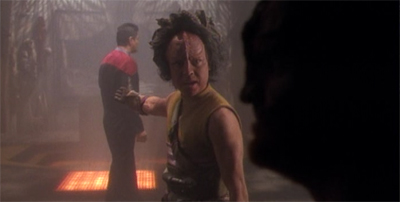
To be fair, most other initiates probably aren’t asked to kill a member of the regular cast of a long-running television show in its second season…
Initiations is not a classic, but it’s a solidly-constructed episode. It’s a lot tighter and more effective than most Voyager scripts to this point. While The 37’s tried and failed to kick off the second season with bold statement of intent, Initiations adopts and accomplishes a much more basic objective: it assures us that the show can produce well-made Star Trek.
Filed under: Voyager | Tagged: chakotay, initiations, Jeri Taylor, kar, kazon, kazon oogla, kenneth biller, legend, Michael Piller, star trek, star trek: voyager, voyager |
















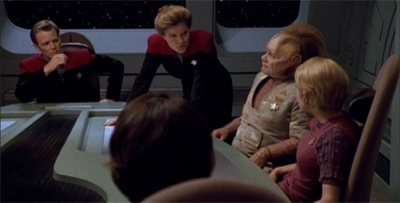
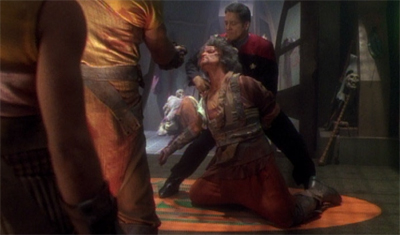
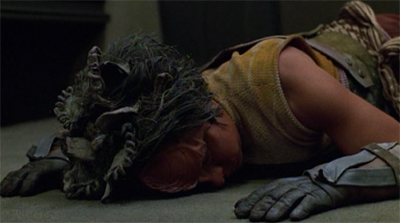
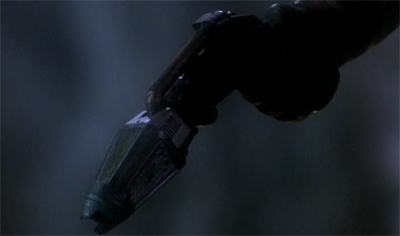



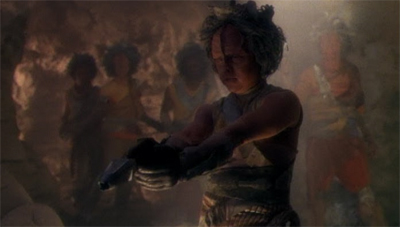
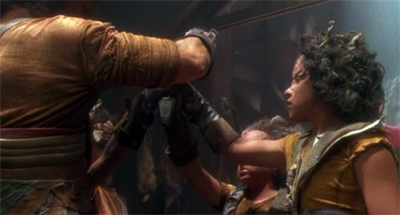

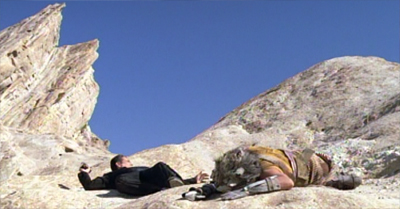
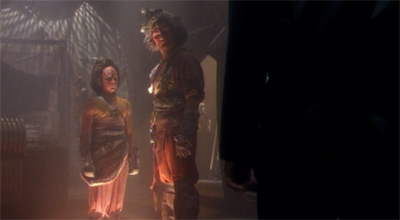
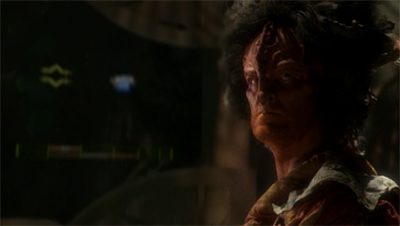
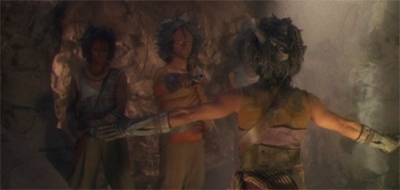

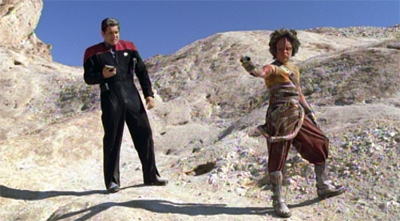





Leave a comment